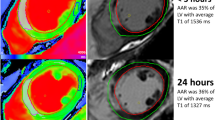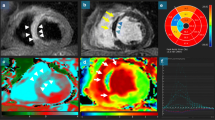Abstract
In the setting of acute myocardial ischemia, the hypoperfused portion of the myocardium is in danger of becoming irreversibly injured. This portion is called the area at risk (AAR). It is of clinical interest to be able to estimate the AAR for further evaluation and improvement of different revascularization strategies. The Alberta Provincial Project for Outcome Assessment in Coronary Heart Disease Score (APPROACH-score) has been shown to be a jeopardy score with a good performance for angiographic assessment of the myocardium supplied by a coronary vessel, representing the AAR. Recently, cardiac magnetic resonance imaging (CMR) has been demonstrated to also provide good results in determining the AAR, especially in the setting of acute ST-elevation infarction patients. Therefore, the aim of our trial was to compare T2-weighted CMR imaging for assessment of AAR in patients with non-ST-elevation myocardial infarction (NSTEMI) and to validate this approach against the angiographic APPROACH-score. We enrolled sixty-four patients presenting with acute NSTEMI that underwent coronary X-ray angiography within 72 h of symptom onset. Two blinded readers performed offline angiographic AAR assessment using the modified APPROACH-score, as being described elsewhere. Furthermore, with the use of a semi-automatic T2w-CMR approach, the AAR was quantified by two fully blinded readers. The resulting mean AAR determined by the modified APPROACH-score was 28.6 ± 10.0 %. The mean CMR derived AAR was 27.6 ± 12.7 %. CMR assessment tended to slightly underestimate the AAR in comparison to angiographic scoring (difference −0.09 ± 7.6 %). There is a good correlation between the AAR assessed by CMR and by angiography (r = 0.65, p < 0.001). T2-weigthed CMR is able to quantify the AAR with very good correlation to the angiographic APPROACH-score in NSTEMI patients.




Similar content being viewed by others
Abbreviations
- AAR:
-
Area at risk
- APPROACH-score:
-
Alberta Provincial Project for Outcome Assessment in Coronary Heart Disease Score
- NSTEMI:
-
Non-ST-elevation myocardial infarction
- CMR:
-
Cardiac magnetic resonance imaging
- CX:
-
Left circumflex
- RCA:
-
Right coronary artery
- LAD:
-
Left anterior descending
References
Lowe JE, Reimer KA, Jennings RB (1978) Experimental infarct size as a function of the amount of myocardium at risk. Am J Pathol 90:363–379
Lee JT, Ideker RE, Reimer KA (1981) Myocardial infarct size and location in relation to the coronary vascular bed at risk in man. Circulation 64:526–534
Horstick G, Heimann A, Gotze O, Hafner G, Berg O, Boehmer P, Becker P, Darius H, Rupprecht HJ, Loos M, Bhakdi S, Meyer J, Kempinski O (1997) Intracoronary application of C1 esterase inhibitor improves cardiac function and reduces myocardial necrosis in an experimental model of ischemia and reperfusion. Circulation 95:701–708
Yellon DM, Hausenloy DJ (2007) Myocardial reperfusion injury. N Engl J Med 357:1121–1135
Graham MM, Faris PD, Ghali WA, Galbraith PD, Norris CM, Badry JT, Mitchell LB, Curtis MJ, Knudtson ML (2001) APPROACH Investigators (Alberta Provincial Project for Outcome Assessment in Coronary Heart Disease). Validation of three myocardial jeopardy scores in a population-based cardiac catheterization cohort. Am Heart J 142:254–261
Gibbons RJ, Holmes DR, Reeder GS, Bailey KR, Hopfenspringer MR, Gersh BJ (1993) Immediate angioplasty compared with the administration of a thrombolytic agent followed by conservative treatment of myocardial infarction. The mayo coronary care unit and catheterization laboratory groups. N Engl J Med 328:685–691
Kastrati A, Mehilli J, Dirschinger J, Schricke U, Neverve J, Pache J, Martinoff S, Neumann FJ, Nekolla S, Blasini R, Seyfarth M, Schwaiger M, Schomig A (2002) Myocardial salvage after coronary stenting plus abciximab versus fibrinolysis plus abciximab in patients with acute myocardial infarction: a randomised trial. Lancet 359:920–925
Pennell D (2006) Myocardial salvage: retrospection, resolution, and radio waves. Circulation 113:1821–1823
Wagner A, Marholdt H, Holly TA, Elliott MD, Regenfus M, Parker M, Klocke FJ, Bonow RO, Kim RJ, Judd RM (2003) Contrast-enhanced MRI and routine single photon emission computed tomography (SPECT) perfusion imaging for detection of subendocardial myocardial infarcts: an imaging study. Lancet 361:374–379
Simonetti OP, Finn JP, White RD, Laub G, Henry DA (1996) “Black blood” T2-weighted inversion-recovery MR imaging of the heart. Radiology 199:49–57
Nilsson JC, Nielsen G, Groenning BA, Fritz-Hansen T, Sondergaard L, Jensen GB, Larsson HB (2001) Sustained postinfarction myocardial oedema in humans visualized by magnetic resonance imaging. Heart 85:639–642
Aletras AH, Tilak GS, Natanzon A, Hsu LY, Gonzalez FM, Hoyt RF, Arai AE (2006) Retrospective determination of the area at risk for reperfused acute myocardial infarction with T2-weighted cardiac magnetic resonance imaging: histopathological and displacement encoding with stimulated echoes (DENSE) functional validations. Circulation 113:1865–1870
Friedrich MG, Abdel-Aty H, Taylor A, Schulz-Menger J, Messroghli D, Dietz R (2008) The salvaged area at risk in reperfused acute myocardial infarction as visualized by cardiovascular magnetic resonance. J Am Coll Cardiol 51:1581–1587
Ortiz-Perez JT, Meyers SN, Lee DC, Kansal P, Klocke FJ, Holly TA, Davidson CJ, Bonow RO, Wu E (2007) Angiographic estimates of myocardium at risk during acute myocardial infarction: validation study using cardiac magnetic resonance imaging. Eur Heart J 28:1750–1758
Abdel-Aty H, Cocker M, Meek C, Tyberg JV, Friedrich MG (2009) Edema as a very early marker for acute myocardial ischemia: a cardiovascular magnetic resonance study. J Am Coll Cardiol 53:1194–1201
Carlsson M, Ubachs JF, Hedstrom E, Heiberg E, Jovinge S, Arheden H (2009) Myocardium at risk after acute infarction in humans on cardiac magnetic resonance: quantitative assessment during follow-up and validation with single-photon emission computed tomography. J Am Coll Cardiol Img 2:569–576
Fuernau G, Eitel I, Franke V, Hildebrandt L, Meissner J, de Waha S, Lurz P, Gutberlet M, Desch S, Schuler G, Thiele H (2011) Myocardium at risk in ST-segment elevation myocardial infarction comparison of T2-weighted edema imaging with the MR-assessed endocardial surface area and validation against angiographic scoring. J Am Coll Cardiol Img 4:967–976
Xu J, Song YB, Hahn JY, Chang SA, Lee SC, Choe YH, Choi SH, Choi JH, Lee SH, Oh JK, Gwon HC (2011) Comparison of magnetic resonance imaging findings in non-ST-segment elevation versus ST-segment elevation myocardial infarction patients undergoing early invasive intervention. Int J Cardiovasc Imaging. doi:10.1007/s10554-011-9975-2
Alpert JS, Thygesen K, Antman E, Bassand JP (2000) Myocardial infarction redefined—a consensus document of The Joint European Society of Cardiology/American College of Cardiology Committee for the redefinition of myocardial infarction. J Am Coll Cardiol 36:959–969
Zalenski RJ, Rydman RJ, Sloan EP, Hahn KH, Cooke D, Fagan J et al (1997) Value or posterior and right ventricular leads in comparison to the standard 12-lead electrocardiogram in evaluation of ST-segment elevation in suspected acute myocardial infarction. Am J Cardiol 79:1579–1585
Schmitt C, Lehmann G, Schmieder S, Karch M, Neumann FJ, Schömig A (2001) Diagnosis of acute myocardial infarction in angiographically documented occluded infarct vessel: limitations of ST-segment elevation in standard and extended ACG leads. Chest 120:1540–1546
Wright RS, Anderson JL, Adams CD et al (2011) 2011 ACCF/AHA focused update incorporated into the ACC/AHA 2007 guidelines for the management of patients with unstable angina/non-ST-elevation myocardial infarction: a report of the American College of Cardiology Foundation/American Heart Association Task Force on Practice Guidelines developed in collaboration with the American Academy of Family Physicians, Society for Cardiovascular Angiography and Interventions, and the Society of Thoracic Surgeons. J Am Coll Cardiol 57:215–367
Wright J, Adriaenssens T, Dymarkowski S, Desmet W, Bogaert J (2009) Quantification of myocardial area at risk with T2-weighted CMR: comparison with contrast-enhanced CMR and coronary angiography. J Am Coll Cardiol Img 2:825–831
Berry C, Kellman P, Mancini C, Chen MY, Bandettini WP, Lowrey T, Hsu LY, Aletras AH, Arai AE (2010) Magnetic resonance imaging delineates the ischemic area-at-risk and myocardial salvage in patients with acute myocardial infarction. Circ Cardiovasc Imaging 3:527–535
Eitel I, Desch S, Fuernau G, Hildebrand L, Gutberlet M, Schuler G, Thiele H (2010) Prognostic significance and determinants of myocardial salvage assessed by cardiovascular magnetic resonance in acute reperfused myocardial infarction. J Am Coll Cardiol 55:2470–2479
Donato P, Coelho P, Santos C, Bernardes A, Caseiro-Alves F (2012) Correspondence between left ventricular 17 myocardial segments and coronary anatomy obtained by multi-detector computed tomography: an ex vivo contribution. Surg Radiol Anat 34(9):805–810
Ortiz-Pérez JT, Rodríguez J, Meyers SN, Lee DC, Davidson C, Wu E (2008) Correspondence between the 17-segment model and coronary arterial anatomy using contrast-enhanced cardiac magnetic resonance imaging. JACC Cardiovasc Imaging 1(3):282–293
Sjögren J, Ubachs JF, Engblom H, Carlsson M, Arheden H, Heiberg E (2012) Semi-automatic segmentation of myocardium at risk in T2-weighted cardiovascular magnetic resonance. J Cardiovasc Magn Reson 31(14):10
2012 Writing Committee Members, Jneid H, Anderson JL, Wright RS, Adams CD, Bridges CR, Casey DE Jr, Ettinger SM, Fesmire FM, Ganiats TG, Lincoff AM, Peterson ED, Philippides GJ, Theroux P, Wenger NK, Zidar JP, Anderson JL. (2012) ACCF/AHA Focused Update of the Guideline for the Management of Patients With Unstable Angina/Non-ST-Elevation Myocardial Infarction (Updating the 2007 Guideline and Replacing the 2011 Focused Update): A Report of the American College of Cardiology Foundation/American Heart Association Task Force on Practice Guidelines. Circulation. 14;126(7):875–910. Epub 2012 Jul 16. PubMed PMID: 22800849
Conflict of interest
The authors state that there neither exists a conflict of interest nor that there a financial information to disclose.
Author information
Authors and Affiliations
Corresponding author
Rights and permissions
About this article
Cite this article
Buckert, D., Mariyadas, M., Walcher, T. et al. Angiographic validation of magnetic resonance assessment of myocardium at risk in non-ST-elevation myocardial infarction. Int J Cardiovasc Imaging 29, 1295–1301 (2013). https://doi.org/10.1007/s10554-013-0210-1
Received:
Accepted:
Published:
Issue Date:
DOI: https://doi.org/10.1007/s10554-013-0210-1




